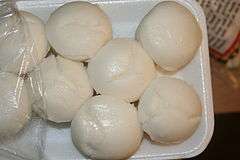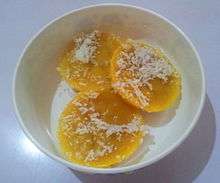Puto
|
Puto in banana leaf liner | |
| Course | Dessert, breakfast |
|---|---|
| Place of origin | Philippines |
| Serving temperature | hot, warm, or room temperature |
| Main ingredients | Rice |
| Variations | puto bumbong |
| 587[1] kcal | |
|
| |

Puto is a type of steamed rice cake usually served as snack or as accompaniment to savory dishes such as dinuguan or pancit in Philippine cuisine and believed to be derived from Indian puttu of Kerala origin. It is eaten as is or with butter and/or grated fresh coconut, or as an accompaniment to a number of savoury viands (most notably, dinuguan).
Preparation
The most common shape of the putuhán or steamer used in making puto is round, ranging from 30 to 60 centimetres (12 to 24 in) in diameter and between 2 to 5 centimetres (0.79 to 1.97 in) deep. These steamers are rings made of either soldered sheet metal built around a perforated pan, or of thin strips of bent bamboo enclosing a flat basket of split bamboo slats (similar to a dim sum steamer basket). The cover is almost always conical to allow the condensing steam to drip along the perimeter instead of on the cakes.
A sheet of muslin (katsâ) is stretched over the steamer ring and the prepared rice batter poured directly on it; an alternative method uses banana leaf as a liner. The puto is then sold as large, thick cakes in flat baskets called bilao lined with banana leaf, either as whole loaves or sliced into smaller, lozenge-shaped individual portions.
The traditional method takes time, although most of it involves inactive waiting periods. The process spans three to four days from the initial rice soaking to taking the finished product out of the steamer.
Taste and texture
Properly prepared puto imparts the slightly yeasty aroma of fermented rice batter with a light whiff of anise. It should be neither sticky nor dry and crumbly, but soft, moist, and with a fine, uniform grain. The essential flavour should be of freshly cooked rice, but it may be sweetened a bit if eaten by itself as a snack instead of as accompaniment to savoury dishes. Since most puto as cooked in the Tagalog-speaking regions may contain a small quantity of wood ash lye and are sometimes steamed and served on banana leaves, some puto aficionados seek these subtle flavours in well-made, traditional puto.
In the last few decades, home cooks and mass producers have experimented with variations in the shape, texture, flavouring and colour of puto. Shortcuts and poor-quality ingredients might have prompted some cooks to introduce foreign flavourings such as vanilla or unusual hues such as pink and electric green to compensate for deficiencies in the pastry's traditional qualities.
Variants
While puto is a common food throughout the Philippines, there are numerous variations by area and family. It is common knowledge that the best-tasting rice is that which is newly harvested followed by rice from the previous harvest, and a common method to improve its flavour is to include a knot of Pandanus amaryllifolius (pandán, "screwpine") leaves in the pot. However, since there seems to be common agreement that aged rice is more suitable for making puto, this fresh flavour is therefore absent and it is necessary to use water in which pandán leaves have been steeped.
Certain towns of the Philippines, most notably Biñan City, Laguna; Valenzuela City, Calasiao, Pangasinan and Manapla, Negros Occidental have excelled in the production and marketing of their particular style of puto that their names are used to identify the variety.[2]
- Puto bumbong (Malay: putu bambu) - Traditionally made from a special variety of sticky or glutinous rice (called pirurutong) which has a distinctly purple colour. The rice mixture is soaked in saltwater and dried overnight and then poured into bumbóng (bamboo tube) and then steamed until steam rises out of the bamboo tubes. It is served topped with butter or margarine and shredded coconut mixed with brown sugar. It is commonly eaten during Christmas in the Philippines along with bibingka, another type of rice cake.[3]
- Puto kutsinta (typically just called kutsinta or cuchinta)- A steamed rice cake similar to puto, but is made using lye. It is characteristically moist and chewy, and can range in color from reddish brown to yellow or orange in coloration. It is typically topped with shredded coconut meat.[4][5]
- Puto lanson - Puto from Iloilo which is made of grated cassava, and is foamy when cooked.[6]
- Puto manapla - A variant made specifically of Saba banana leaves underneath that impart its flavour.[7]
- Puto mamón - A puto mixture that has no rice but combines egg yolks, salt and sugar. A mixture of milk and water and another of flour are alternately mixed into the yolks, then egg whites are beaten and folded in before the dough is poured into muffin cups and steamed for 15 to 20 minutes.[8][9]
- Puto maya - made from glutinous violet rice (called tapol) soaked in water, drained and then placed into a steamer for 30 minutes. This rice mixture is then combined with coconut milk, salt, sugar and ginger juice and returned to the steamer for another 25 to 30 minutes.[6]
- Puto-Pao - A combination of siopao (meat-filled bun) and puto. It uses the traditional puto recipe but incorporates a spiced sweetmeat filling.
- Puto seko - literally "dry puto" in Spanish, this is more in the form of a powdery biscuit.[10]
 The Filipino dish Dinuguan is traditionally served with puto |
Special, assorted puto from Baliuag, Bulacan. |
 Package of store-bought puto |
Puto Popsicle cake at a competition in SM City Baliuag. |
 Puto kutsinta topped with grated coconut. |
See also
References
- ↑ "Puto Recipe". Retrieved 2008-08-26.
- ↑ Calasiao Puto
- ↑ Alvin Elchico, Gracie Rutao and JV Dizon (2010-12-24). "Filipinos go for ham, bibingka for Christmas". http://www.abs-cbnnews.com/. Retrieved January 6, 2011. External link in
|publisher=(help) - ↑ Vanjo Merano (6 September 2009). "Kutsinta Recipe". PanlasangPinoy. Retrieved 15 January 2015.
- ↑ "Puto". Rice Recipes. Philippine Rice Research Institute. Retrieved 15 January 2015.
- 1 2 "Dreaming of Rice Cakes". Retrieved 2009-03-21.
- ↑ Micky Fenix (May 31, 2007). "Dreaming of rice cakes". Philippine Daily Inquirer - Lifestyle section. Retrieved February 17, 2011. External link in
|publisher=(help) - ↑ Cordero-Fernando, Gilda; Baldemor, Manuel D. (1992). Philippine food & life: Luzon. Anvil Pub.
- ↑ Schlau, Stacey; Bergmann, Emilie L. (2007). Approaches to teaching the works of Sor Juana Inés de la Cruz. Modern Language Association of America.
- ↑ How to make puto seko | Filipino recipes | Pinterest
External links
| Wikimedia Commons has media related to Puto. |
- Puto Cheese Recipe
- Puto Recipes
- Authentic Filipino Food Recipes
- Enliven Christmas with Puto Bumbong and Bibingka
- Easy White Puto Recipe

.jpg)